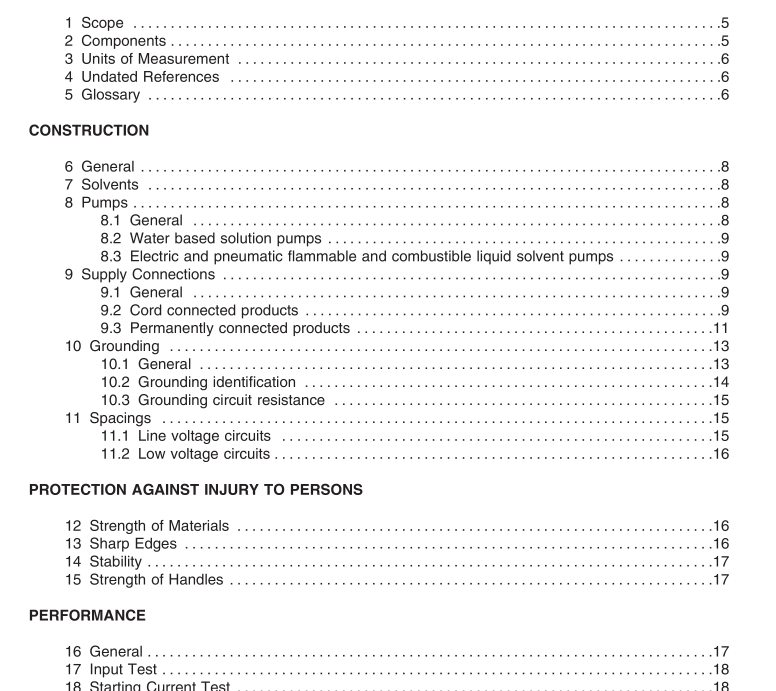UL 1204:2018 free download Parts Cleaners
1 Scope
1.1 These requirements cover parts cleaners used for cleaning or removing grease and similarsubstances from the item contaminated.
1.2 These requirements cover electrically operated parts cleaners rated up to 600 v, and manual typeparts cleaners with no electrical connection.
1.3 These units are intended for use with flammable/combustible liquids or non-flammable/non-combustible cleaning solutions as detailed in the instruction manual provided with the unit and labels onthe unit.
1.4 Requirements for the installation and use of parts cleaners are included in the National ElectricalCode,NFPA 70, the Flammable and Combustible Liquids Code,NFPA 30, the Uniform Fire Code,NFPA1, and the International Fire Code,IFC.
1.5 These requirements do not apply to the following:
a) Units intended to be installed outdoors;
b) Units intended for use with solvents or cleaning solutions that are considered unstable; orc) Parts cleaners employing evaporating and condensing solvents.
1.6 These requirements do not address the physiological effects of solvents or cleaning solutions usedwith the equipment or any hazardous waste generated by the equipment.
2 Components
2.1 Except as indicated in 2.2, a component of a product covered by this standard shall comply with therequirements for that component. See Appendix A for a list of standards covering components used in theproducts covered by this standard.
2.2 A component is not required to comply with a specific requirement that:
a) lnvolves a feature or characteristic not required in the intended application of the componentin the product covered by this standard, or
b) ls superseded by a requirement in this standard.
2.3 A component shall be used in accordance with its rating established for the intended conditions ofuse.
2.4 Specific components that are incomplete in construction features or restricted in performancecapabilities may be employed if they are intended for use only under limited conditions,such as certaintemperatures not exceeding specified limits, and shall be used only under those specific conditions.
3 Units of Measurement
3.1 Values stated without parentheses are the requirement.Values in parentheses are explanatory orapproximate information.
4 Undated References
4.1 Values stated without parentheses are the requirement.Values in parentheses are explanatory orapproximate information.
5 Glossary
5.1 For the purposes of this standard, the following definitions apply.
5.2 AUTO-IGNITION TEMPERATURE – The minimum temperature at which fuel-air mixtures will ignitespontaneously.This temperature is to be determined either at atmospheric pressure (14.7 psig), or at themaximum pressure present in the area of the fuel-air mixture,whichever is higher. At atmosphericpressure, the auto-ignition temperature of a solvent shall be determined in accordance with the StandardTest Method for Auto-lgnition Temperature of Liquid Chemicals,ASTM E 659.
5.3 COMBUSTIBLE LIQUID – A material that has a fluidity greater than 300 penetration asphalt whentested in accordance with the Standard Test Method for Penetration for Bituminous Materials,ASTMD 5,and that has a closed cup flash point at or above 37.8°C(100°F).Combustible liquids are subdivided asfollows:
a)Class ll liquids include those having flash points at or above 37.8°C and below 60C (140°F);
b) Class lllA liquids include those having flash points at or above 60C and below 93 ℃ (200°F);and
c) Class lB liquids include those having flash points at or above 93°℃.
UL 1204:2018 free download
